Title : HPTLC fingerprint of phytochemicals in curcuma inodora blatt variants & curcuma species from melghat forests
Abstract:
HPTLC based methods are being explored as an important tool in routine drug analysis. HPTLC screening reveals the species' relatedness and uniqueness. HPTLC fingerprint of a plant species provide information for identification, standardization and quality control of the medicinal plant. A total of 120 species in the genus Curcuma L. (Zingiberaceae), most of which are found in South and South-East Asia although a few are also found in China, Australia, and the South Pacific. Among 120 species reported throughout the world 40 are from India, 8 are from Maharashtra State, and four are reported from Melghat District, Amravati, Maharashtra. Of these, C. longa L. is cultivated, while C. inodora Blatt., C. pseudomontana J. Graham and C. decipiens are wild. Curcuma inodora Blatt. known as ‘Jangali Halad’ is a common herb widely distributed throughout Maharashtra and is very common and abundant in Melghat. Fresh rhizome paste of C. inodora as a potent antiseptic, is applied to cuts. C. pseudomontana is used in traditional medicine to cure jaundice, diabetes, body swellings, and to increase lactation. C. inodora populations in the Melghat region have been observed to exhibit numerous different variations in both aerial and underground characters. Twelve distinct variants of C. inodora (CI-1-12) and single accession each of C. pseudomontana (CP-13) and C. longa (CL-14) were collected. In present study of HPTLC fingerprinting two different derivatization systems were used. Variants CI- 1, 3, 4, 5, 7 and 10 show the similar band with Rf value of 0.91. Bands at 0.09, 0.77 and 0.91 Rf values are the most common chemical compounds in most of the samples. The maximum number of peaks i.e. 9 produced in CI- 4, 5,6,7,11,12, CP-13 and CL-14 indicate the presence of nine compounds in the sample. HPTLC profiles of flavonoid obtained for the 14 samples studied are significantly different. Peak at 0.88 Rf value is the most common chemical compound present in 50% samples. Significant differences in banding pattern and Rf values were seen in the phenolics profile. With the exception of C. longa, one of the phenolic compounds with a 0.75 Rf value is the most prevalent chemical. Amino acids were detected with the HPTLC method. Sample CI-3 and 5 showed maximum i.e. 11 amino acids. Glycine and Proline were detected in all accessions; they appear to characterize the Curcuma species studied. HPTLC fingerprint used for documentation and quantification of chemical markers to identify morphological and geographical variation.
Key words: Curcuma inodora Blatt.; Curcuma pseudomontana J. Graham; Curcuma longa L. Melghat Forest; HPTLC; Flavonoid; Phenolics ; Amino acids.
Audience Take Away Notes:
- HPTLC techniques will be use understand
- Use of HPTLC for fingerprinting of plant samples and to find adulteration in the various herbal formulations


